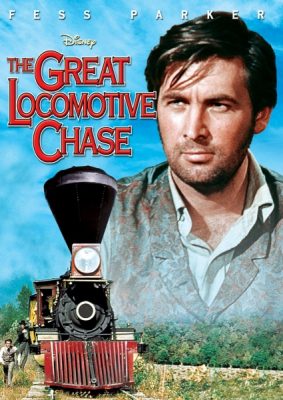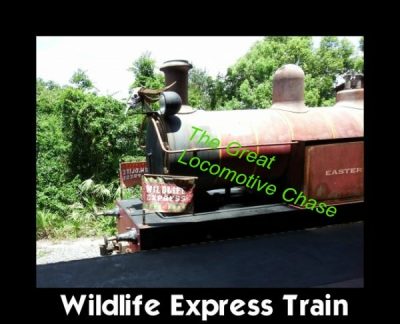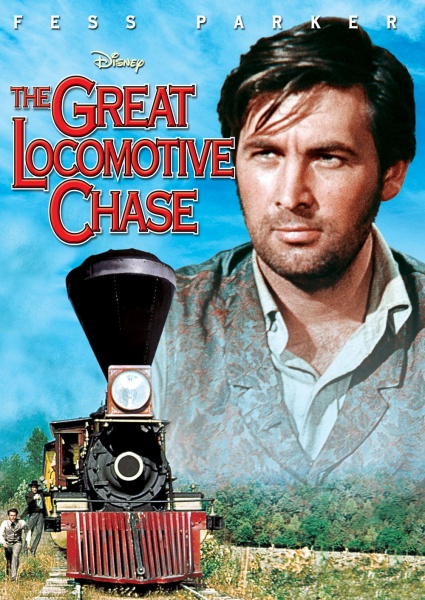
Based closely on actual events that occurred during the American Civil War, Disney’s The Great Locomotive Chase was theatrically released on June 8, 1956. The live action drama is eighty-seven minutes in length.
Plot Summary and Andrews Raid
The Great Locomotive Chase portrays the Andrews Raid of April 12, 1862 using the actual names of the relevant people and places.
The story is told as a flashback by William Pittenger (John Lupton), one of the soldiers involved in the raid. In essence, a civilian smuggler, scout, and spy named James J. Andrews (Fess Parker) devises a plan whereby Andrews and a group of Union soldiers, including Pittenger, William Campbell (Jeff York), Robert Buffum (Eddie Firestone), and Jacob Parrott (Claude Jarman, Jr.), will steal a locomotive, the General, during a breakfast stop between Marietta, Georgia and Chattanooga, Tennessee; destroy communication networks, including telegraph wires, bridges, and railroad tracks, along the route; and meet with Union forces under the command of Brigadier General Ormsby M. Mitchel at Chattanooga, a rendezvous that will give the Union troops control of one of the Confederacy’s greatest hub cities. (1) With control of Chattanooga, Union forces would be able to effectively curtail communication among various parts of the Confederacy and possibly force a quick surrender, especially since many Tennessee residents supported the Union.
In the end, however, the successful theft of the General results in few tangible benefits for the Union cause, although nineteen of the soldiers who worked with Andrews were among the earliest recipients of the Medal of Honor. (2) Upon realizing during the breakfast stop that the General has been seized, conductor William A. Fuller (Jeffrey Hunter) commences an epic ninety-mile chase on both foot and aboard other trains. (3) The journey culminates triumphantly for Fuller when the conductor catches up with the General aboard the Texas, which was ridden backwards for nearly fifty miles. (4) Fuller and the Confederates survived the raid, but the Union eventually prevailed in the overall war.
Production
Walt Disney loved both trains and American history, so a movie combining these two elements was a natural fit for his studio. Filming of The Great Locomotive Chase occurred over six weeks in late-1955 along a thirty-five-mile stretch of the Tallulah Falls Railroad, which ran for fifty-eight miles between Cornelia, Georgia and Franklin, North Carolina. For the locomotives, Walt Disney secured the William Mason from the Baltimore and Ohio Railroad Museum to portray the General and the Inyo from Paramount to portray the Texas. Local residents were liberally used as extras, and Walt Disney attended most of the filming sessions. Years later, one local resident, Ernest Anderson, recalled, “You ought to have been around when Walt Disney was making that picture up there. He really paid you something. He gave you fifty dollars a week extra, just to buy your Coca-Colas with, outside of your salary; then you got your dinner and supper made.” (5)
Deception
One of the difficulties of spying is the need to continuously deceive one’s opponent. To this end, Andrews feels guilty about lying to a close Confederate friend, and Campbell struggles to control his anger while his fellow soldiers profusely but disingenuously praise the Southern war effort.
Action
The Great Locomotive Chase features its share of action scenes, especially toward the end of the film, but these moments are overshadowed by dialogue segments. If you are expecting to see extended shootouts and explosions, you will be disappointed.
On the upside, the film has several moments of immense suspense. For example, when the Texas follows the General into a tunnel, the anxiety of the crew aboard the former train is signified by an extended period of darkness with the only noise coming from the chugging of the train along the track. Prior to the Texas’s entrance, Andrews indecisively contemplates Campbell’s proposal to eliminate the pursuers in the tunnel by releasing one of the General’s boxcars to crash into the Texas. These moments of uncertainty make the viewer feel either like he or she is riding into an ambush or is about to enter a tunnel on a high-speed roller coaster for the first time—perfect storytelling.
Music
Suspenseful background tunes augment the film’s tense martial atmosphere. Additionally, several short lyrical numbers are incorporated into the effort. The catchy “Dixie’ is sung by the various occupants of the inn with Andrews playing the tune on the house’s piano; “Sons of Old Aunt Dinah” is a pro-Confederate chant performed by the riders on the southbound train to Georgia; “Pappy Was A Railroad Man” is an energetic chant sung by Andrews’s men aboard the stolen train; and “Roll Jordan Roll” is a somber number sung by Andrews’s men while awaiting execution in the prison.
Humor
The Great Locomotive Chase features a few awkward moments that might make you chuckle, but the film is hardly a comedy.
A fellow soldier jokingly asks Pittenger, who is reading a newspaper article about the new Congressional Medal of Honor, why he hasn’t paid for a substitute soldier such that he can catch up on his reading.
After telling his men to pretend that they are residents of Kentucky attempting to join the Confederate army if questioned, Andrews cautions the New Englander Robert Buffum to refrain from talking because he [Andrews] has “never met a Kentuckian so plainly from Massachusetts.”
Struggling to contain his anger with the Confederates at the inn, William Campbell manages to half-heartedly sing the final lines of “Dixie.”
When Andrews successfully asks a group of Confederate maintenance workers for some tools, an awed Pittenger says, “I don’t know why we have to take the South. If Andrews asked for it, they’d give it to him.”
The line “Damn Yankees!” and the name James Andrews are both featured in The Great Locomotive Chase. Play ball! (6)
Relationship to Other Disney Films
The Great Locomotive Chase was the second of six Disney films to feature Fess Parker, who was named a Disney Legend in 1991. Parker had previously held the starring role in the classic Davy Crockett, King of the Wild Frontier (1955), and he subsequently contributed to Davy Crockett and the River Pirates (1956), (7) Westward Ho, The Wagons! (1956), Old Yeller (1957), and The Light in the Forest (1958) for the studio.
The Great Locomotive Chase was the first of six Disney films to feature Jeff York. York subsequently appeared in Davy Crockett and the River Pirates, (8) Westward Ho, The Wagons!, Johnny Tremain (1957), Old Yeller, and Savage Sam (1963) for the studio.
The Great Locomotive Chase was the first of six Disney films to feature Slim Pickens, who portrays the Texas’s conductor, Peter Bracken. Pickens subsequently appeared in Tonka (1958), Savage Sam, Never a Dull Moment (1968), The Apple Dumpling Gang (1975), and The Black Hole (1979) for Disney.
Davy Crockett, King of the Wild Frontier, Davy Crockett and the River Pirates, Westward Ho the Wagons!, Johnny Tremain, and The One and Only, Genuine, Original Family Band (1968) were also based on actual events in United States history.
An exciting train scene was featured in Scandalous John (1971).
In appearance, Pittenger is reminiscent of Milo from Atlantis: The Lost Empire (2001).
In the Parks
Multi-station railroad attractions circumnavigate Walt Disney World’s Magic Kingdom and the Disneyland parks in California, Paris, and Hong Kong. When Tokyo Disneyland debuted in 1983, Japanese law prevented Disney from building a multi-station railroad attraction without relinquishing control of said attraction to the Japanese government. (9) Thus, Tokyo Disneyland Park features a smaller railroad attraction, “Western River Railroad,” which runs among that park’s Adventureland, Westernland, and Critter Country sections with only a single station.
Other railroad attractions in Disney’s theme parks include the “Big Thunder Mountain Railroad” roller coasters at the Magic Kingdom and the Disneyland parks in California, Paris, and Tokyo; the “Casey Jr. Circus Train” attraction at the Disneyland parks in California and Paris; and the “Wildlife Express Train” at the Animal Kingdom.

For an additional cost, guests at the Magic Kingdom can take the “Magic Behind Our Steam Trains Tour.”
Elements of the Civil War are discussed in the “Hall of Presidents” show at the Magic Kingdom, the “American Adventure” show at Epcot, and the “Disneyland Story presenting Great Moments with Mr. Lincoln” show at Disneyland Park.
Early in The Great Locomotive Chase, Andrews and his followers consume fried chicken at an inn. Guests at Walt Disney World can order fried chicken at Fort Wilderness’s “Trail’s End,” Fort Wilderness’s “Hoop Dee Doo Revue” dinner show, Disney’s Hollywood Studios’s “‘50s Prime Time Café,” and Disney Springs’s “Homecomin’.”
Overall
The Great Locomotive Chase is a good Disneyfied history lesson, but the effort is not as exciting as the plot description might indicate.
Notes
1) Kathleen Thompson, “The Great Locomotive Chase: Part I, The Plan,” Civil Discourse: A Blog of the Long Civil War Era (blog), August 22, 2016, accessed June 4, 2018.
2) —, “The Great Locomotive Chase: Part IV, The Medal of Honor,” Civil Discourse: A Blog of the Long Civil War Era (blog), September 12, 2016, accessed June 4, 2018.
3) —, “The Great Locomotive Chase: Part II, The Chase,” Civil Discourse: A Blog of the Long Civil War Era (blog), August 29, 2016, accessed June 4, 2018.
4) Ibid.
5) Michael Crawford, “Making The Great Locomotive Chase,” The Walt Disney Family Museum, October 3, 2011, accessed June 4, 2018, https://www.waltdisney.org/blog/making-great-locomotive-chase.
6) The [New York] Yankees are a professional baseball team, and one [Dr.] James Andrews often informs baseball pitchers that they require “Tommy John Surgery” to repair elbow damage.
7) The two portions of what became Davy Crockett and the River Pirates, “Davy Crockett’s Keelboat Race” and “Davy Crockett and the River Pirates,” originally aired on Walt Disney’s weekly ABC-TV program, “Disneyland,” on November 16, 1955 and December 14, 1955, respectively. The packaged theatrical release of these efforts as Davy Crockett and the River Pirates did not come until July 18, 1956, more than one month after the release of The Great Locomotive Chase.
8) Ibid.
9) Jack Spence, “Adventureland—Tokyo Disneyland,” AllEars.Net (blog), July 27, 2008, accessed May 30, 2018, http://land.allears.net/blogs/jackspence/2008/07/adventureland_tokyo_disneyland.html.
What do you think of The Great Locomotive Chase? Let me know in the comments!
Sponsored Ad: Would you like to help support The Mouse For Less website in continuing their mission of being THE Disney vacation planning resource? You can do so by purchasing The Great Locomotive Chase from our Affiliate Link through Amazon. Thanks so much for your support!
Did you like this article? Make sure to share it with your friends! Check below for easy ways to share!
Incoming search terms:
- https://www themouseforless com/blog_world/movie-review-the-great-locomotive-chase/
- disney great locomotive chase cut
- great locomotive chase dinsey

